Cocoon Papers and the Bell Clock Tower: Hotel Kazusaya in Nihonbashi

Hotel Kazusaya is an elegant, comfortable hotel located in Tokyo's Nihonbashi district. Staying here is a chance to experience exquisite Japanese hospitality and learn about the fascinating history of Nihonbashi, which has been frequented by famous personalities since the Edo period (1603-1868).
Welcome back to Tokyo Ryokan Stories! I’m Roza Akino, and I live and work in Japan. Thanks for joining me on my journey to explore the lesser-known inns and hotels in Tokyo!
Today I’m visiting one of my favorite areas in Tokyo, Nihonbashi—a modern chic area with many long-standing shops and businesses that add a traditional touch. While areas like Ginza are known tourist spots, Nihonbashi is still a hidden gem with all the perks of luxury shops without the crowds.
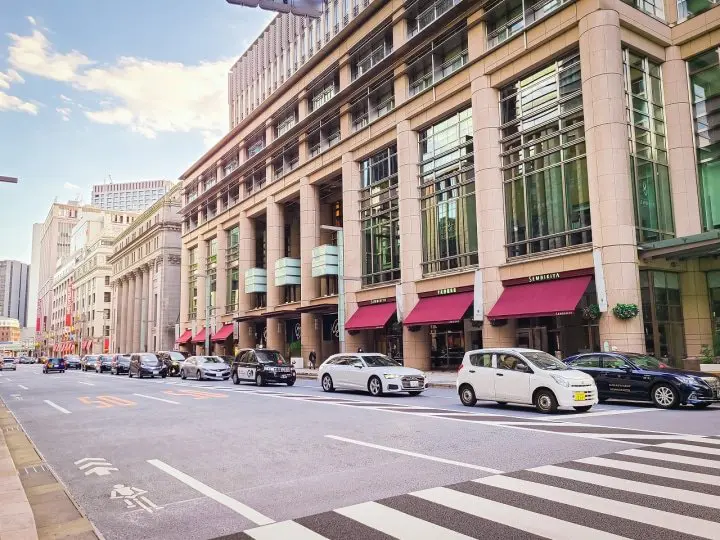
One of the main streets in the Nihonbashi area
I make my way to Hotel Kazusaya, five minutes away from Mitsukoshimae Station on the Tokyo Metro Line, and less than a minute from the JR Shin-Nihonbashi Station on the JR Sobu Main Line. I pass by the familiar landscape of the various department stores that line the main Nihonbashi area and make a turn into one of the smaller streets, finding myself facing the beautiful 10-story hotel building.
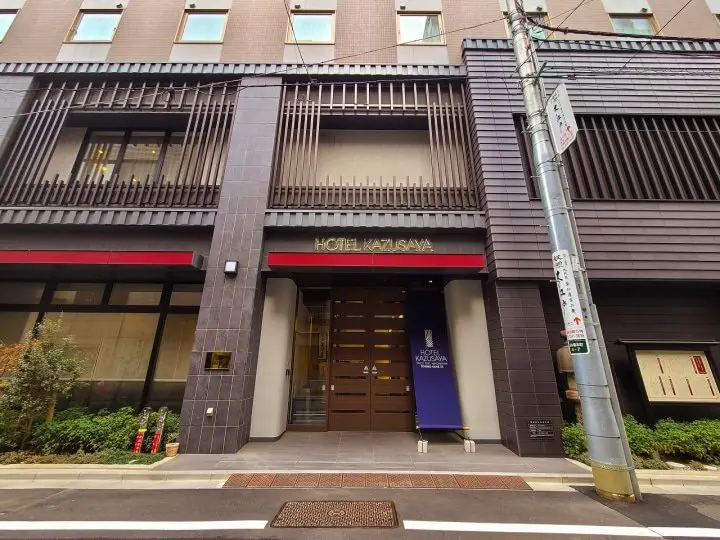
The outside entrance of the hotel
The hotel looks new, the design clean. The outside entrance, while very modern, has hints of traditional architecture. When I enter the lobby, I notice the minimalist design and the subdued colors that have been implemented throughout the building. The hidden lighting adds warmth and just the right amount of brightness, without being overwhelming.
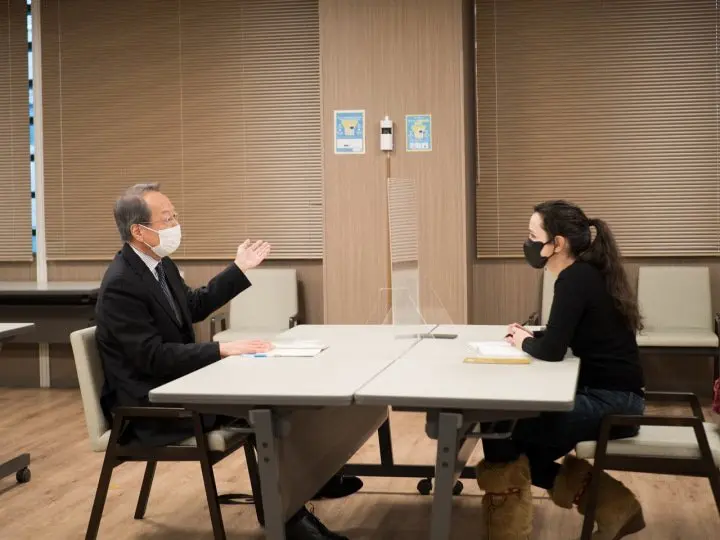
Kudo-san and I
I meet with Tetsuo Kudo-san, president and 4th generation owner of the hotel, in the conference room on the second floor of the hotel. Kazusaya is a hotel with a long history, founded in 1891. How did it come to be? What changes has it been through? I am fascinated by the historical changes that the hotel must have witnessed through the ages, and so I sit down to hear its story.
Hotel Kazusaya was started by Kudō-san’s great grandfather who was born in Nagano in 1863 during the Meiji Restoration, a time when the feudal government was abolished in favor of a centralized government. At the time, his grandfather worked in the silk industry. Kudo-san explains the various jobs in the silk industry: spinning thread, raising silk worms, weaving silk. However, he says, there was another job in the silk industry that is no-longer existent: selling paper that had silkworm cocoons attached to it.
Paper with silkworm cocoons? I must admit that while I love kimono, I had never heard of such an occupation before.
Kudo-san continues, “I had always wondered: my grandfather, a young country boy, came to Tokyo and bought this ryokan at age 27. How did he get enough money to do that?”
This mystery was solved when Kudo-san happened to come across a documentary that talked about these cocoon papers. Apparently, at the time there was a sickness that killed off many of the silkworms in Europe, and silkworms were a precious commodity. Japan became known for its high-quality silk, and the international silk trade took off—these papers with silk worm cocoons attached to them were especially in high demand in Europe and America. Only a few places in Japan had permission from the government to produce the official papers used for the cocoons, and one of these places was (you guessed it) in Nagano, close to where his grandfather was from.
With this new information the mystery was solved— Kudō-san’s grandfather’s success is likely due to this close proximity to the town where the papers were produced, allowing him to make the silk cocoon papers and sell them both domestically and abroad. This must have been enough to make a high profit, enough to buy a ryokan in Nihonbashi! The ryokan he bought was Kazusaya Ryokan, and the name was kept through the change of ownership.
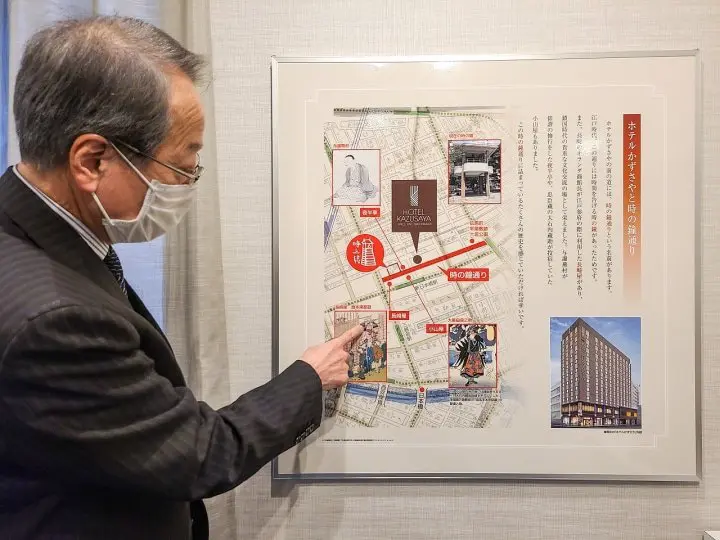
A historical map of Nihonbashi in the Edo period
Kudo-san continues to say that throughout the Edo period, and even leading into the early Meiji period, Nihonbashi was the only part of Edo where commoners were allowed to live. When thinking of Edo, many people imagine the current Tokyo area, just in its pre-modern state. However, area thought of as the Edo town area at the time was very small—it basically consisted of the area we now know as Nihonbashi. The area beyond where the current Yamanote line was all devoted to samurai residences, surrounding Edo castle.
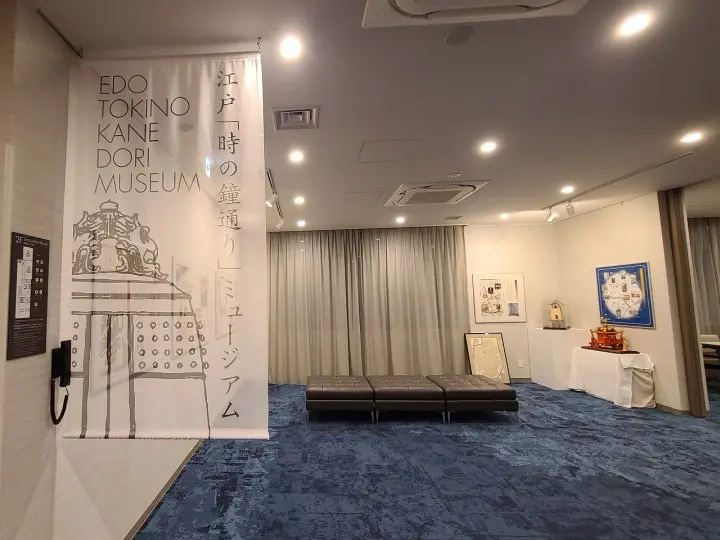
The Edo Tokino Kane Dori Museum on the second floor—a space that displays historical maps and plaques talking about the history of the hotel
While the biggest business district in the area was a street a few blocks away, Hotel Kazusaya is located right behind what was the second-biggest business district, meaning that even at the time it was a prime piece of real estate.
Through its history of over 130 years the hotel has been rebuilt several times, but its latest transformation has been the most dramatic. With an increase in inbound travelers and in order to prepare for the 2020 Olympics, the hotel was completely rebuilt, more than doubling its original room count from 71 rooms to 154. It was just recently reopened in July of 2020 in its full glory.
Kudo-san explains that with the increase of new hotels in the area, he wanted to make sure that the redesigned Kazusaya would be place where guests could feel that they are in Nihonbashi the moment they step in. How does one convey the spirit of a place through a building? Well, playing with color is one way.
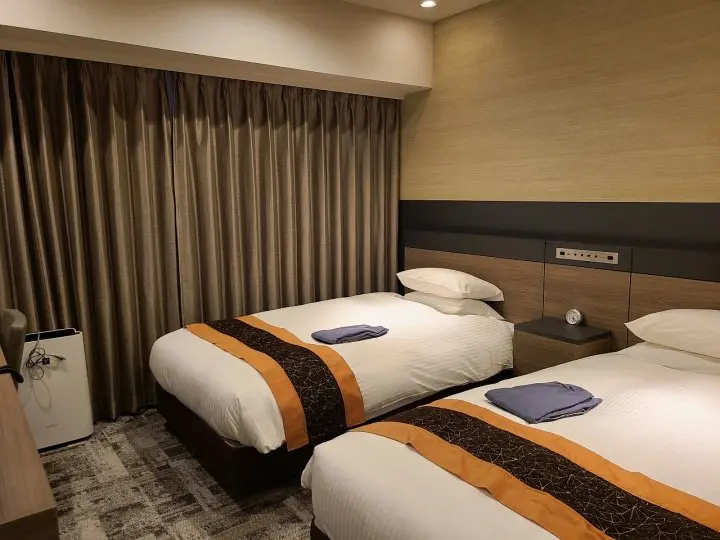
Various shades of blues, browns, and greys make up the color scheme of the entire hotel
Since Nihonbashi was a city of merchants, and during the Edo period (1603-1868) there were strict restrictions on what colors and materials classes outside of samurai and nobility could use and wear, the merchant class decided to express their creativity and their extravagance by mastering the use of 48 shades of brown and 100 shades of grey, colors in addition to indigo blue which were not restricted for their status.
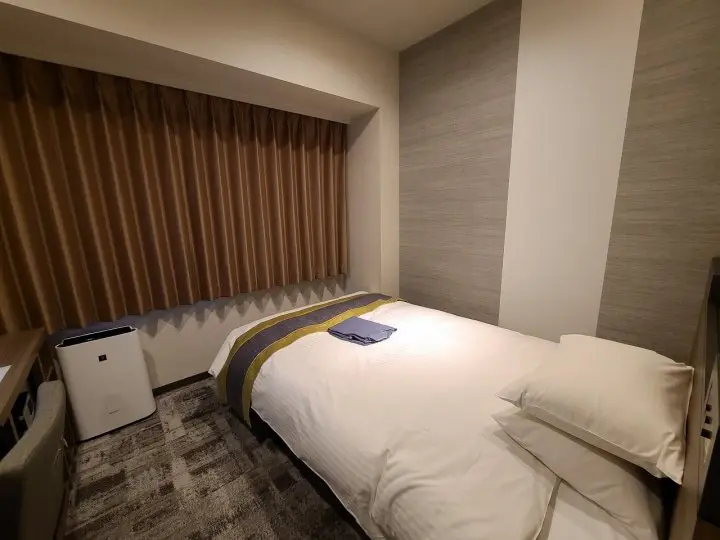
A single room—simple yet chic
This brought about the stylish aesthetic sense of Edo iki. Kudo-san felt that this expression of color was central to what it meant to be a merchant in Nihonbashi, so the new hotel was built to incorporate various shades of bluish grey and brown throughout the building.
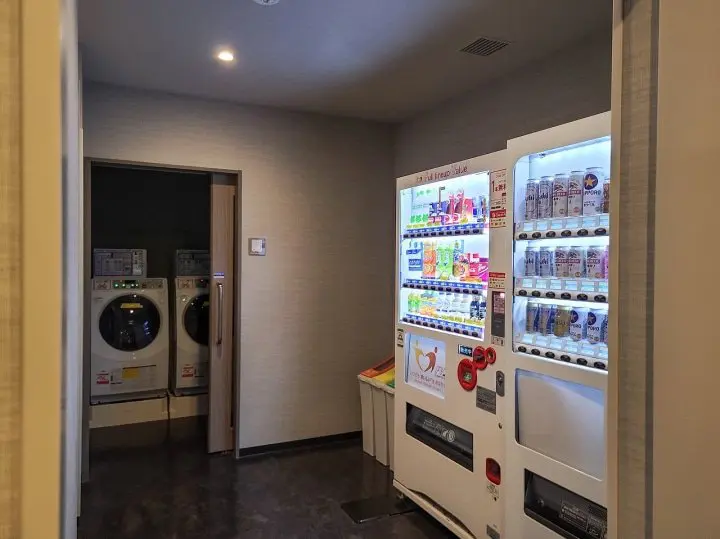
Laundry machines perfect for guests who stay long-term
As I glance at Kudo-san’s business card, I notice it features a photo of the hotel from a distance. I notice that the use of the color scheme has been incorporated into the exterior of the hotel as well, something that I hadn’t noticed when I first approached it.
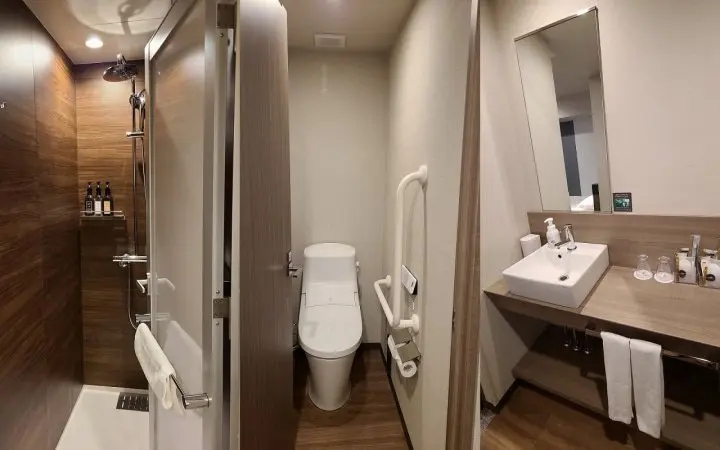
This room has a separate shower, toilet, and sink
While taking a look through the various rooms, I notice the various shades intertwined with each other. The grey carpet with light grey walls, brown curtains. The bathrooms also incorporate brown wood patterns on the wall.
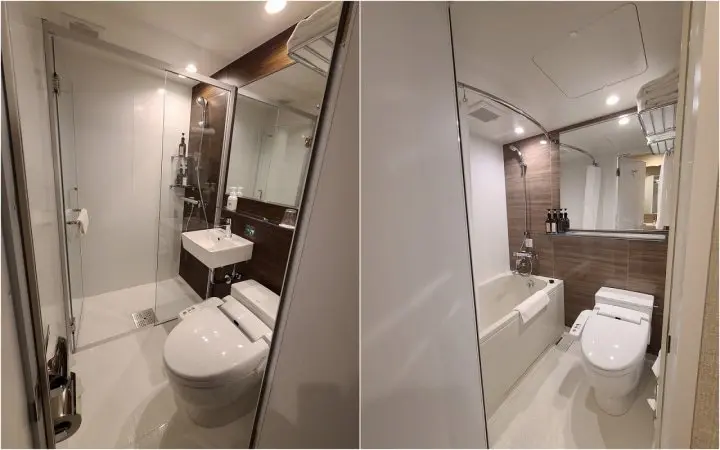
An example of a shower with and without a bath
The rooms come in various sizes single, double, twin, deluxe twin, and even triple. Instead of yukata, each room is stocked with light-indigo-colored samue for its guests. As samue are considered to be traditional working clothes, it seems fitting that the choice of room-wear is a symbolic representation of the traditional working class.
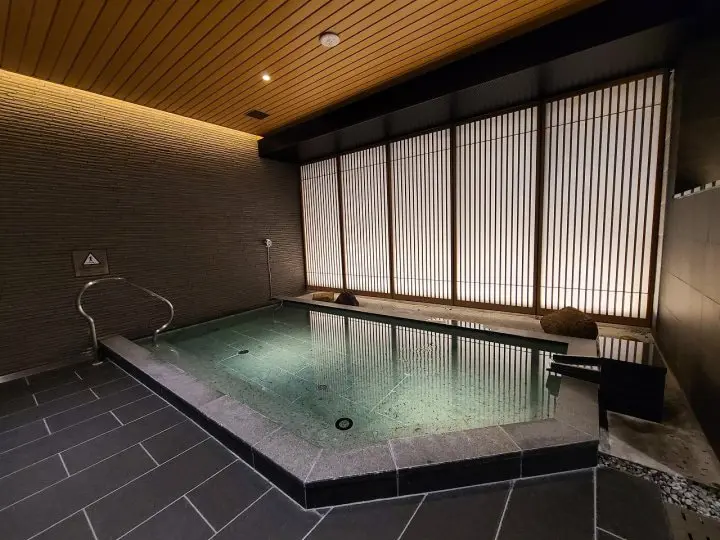
The large bathing area
Kudo-san continues to say that since this hotel came from a ryokan, he wanted to keep one of the features that is commonly found in ryokan: a public bath. This is why half of the rooms are only equipped with a shower—guests who want to take a bath are likely to use the hotel public bath.
Another special feature of the hotel is the water. While tap water is generally drinkable in Tokyo, it’s not particularly delicious. Because the Hotel Kazusaya’s water system has built-in filtration, the tap water in the hotel tastes good and is better for your skin and hair in the shower as well.
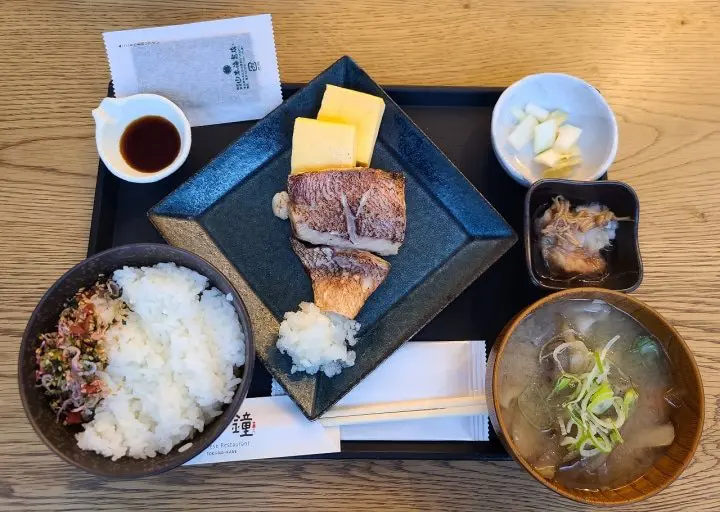
The Japanese-style breakfast served at Toki no Kane
With the new renovation came another addition: a restaurant called Toki no Kane, named after the bell clock tower nearby. This is where the professionally-prepared traditional Japanese breakfast is served to guests in the morning.
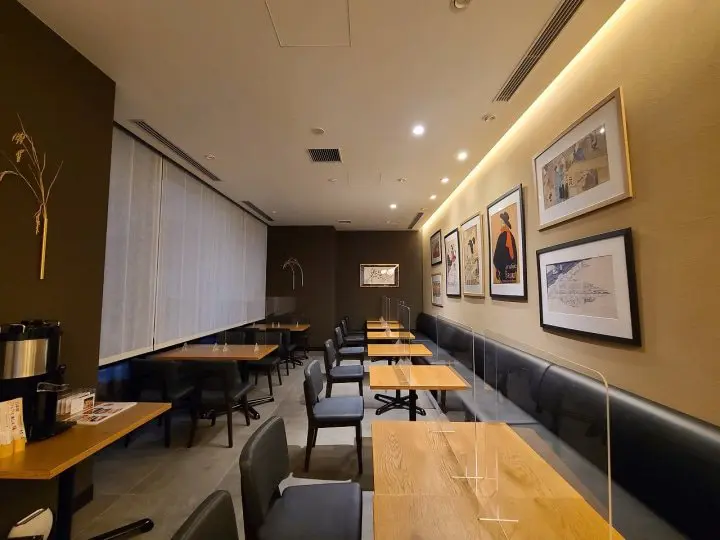
Inside the restaurant
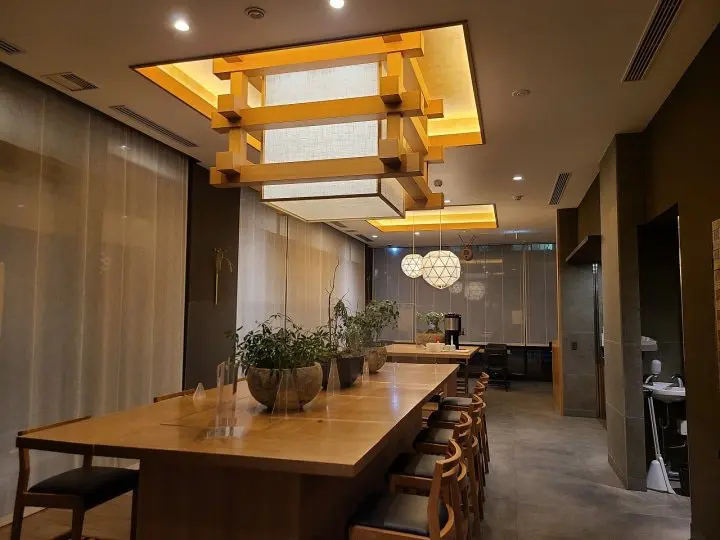
The restaurant displays traditional inspiration in its lighting fixtures
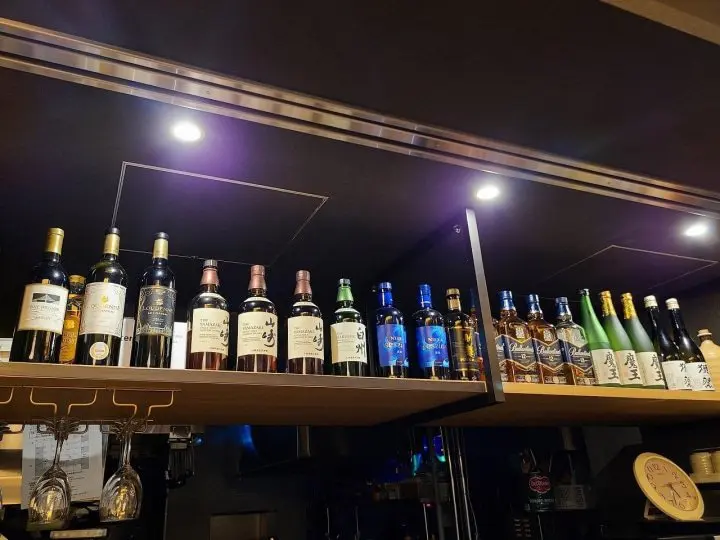
The bar counter at the restaurant, its shelf lined with various whiskies
With the end of our interview, I thank Kudō-san for sharing the rich history of this area with me. I receive my room key a the front desk and am ready to explore.
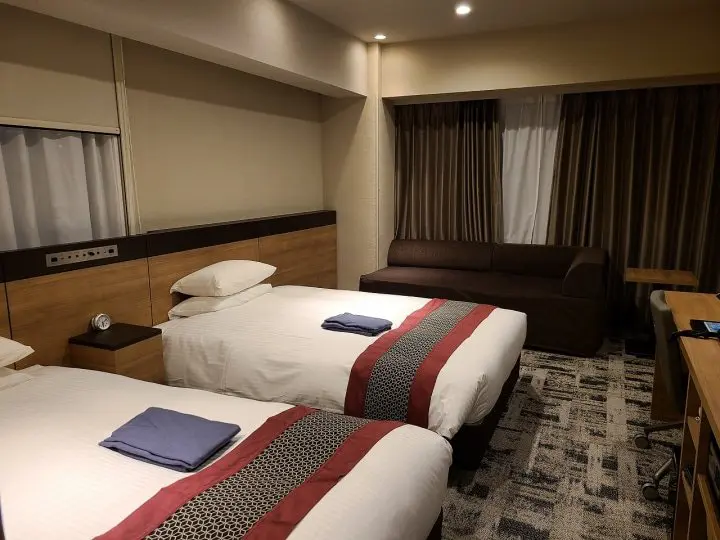
My room—a Deluxe Twin
The elevator requires your room key to unlock access to your floor. My room is a Deluxe Twin with two beds and a small sofa, giving me plenty of room to lounge around. After putting away my things and eating a quick takeaway dinner in my room from one of the nearby restaurants, I set out to relax in the public bath.
Note: If you’re unfamiliar with Japanese public bath manners, it might be a good idea to familiarize yourself in advance for a smooth experience.
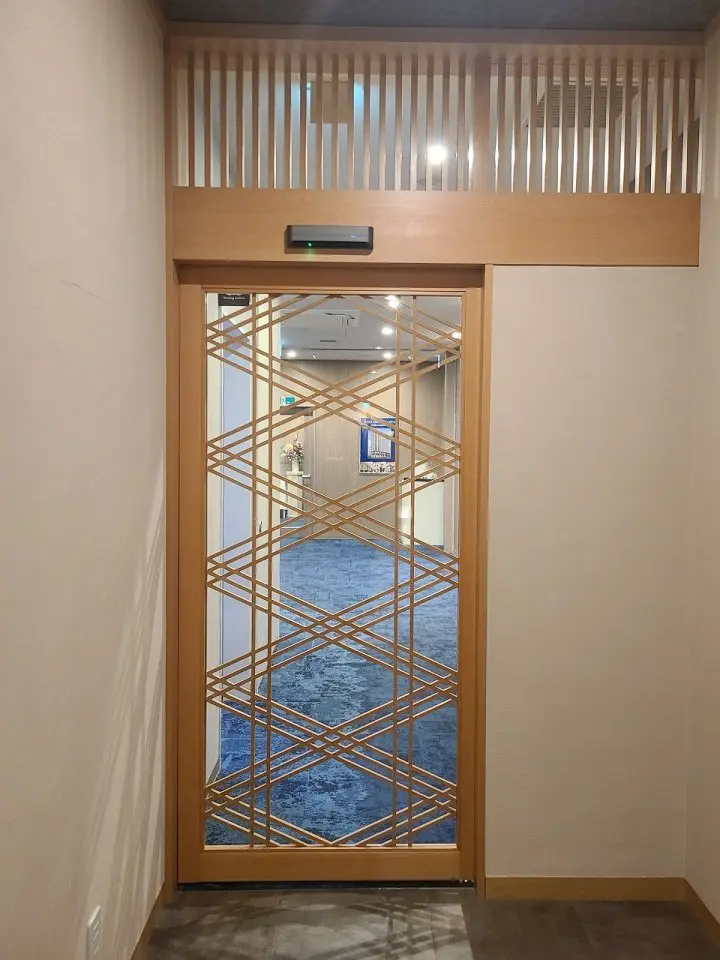
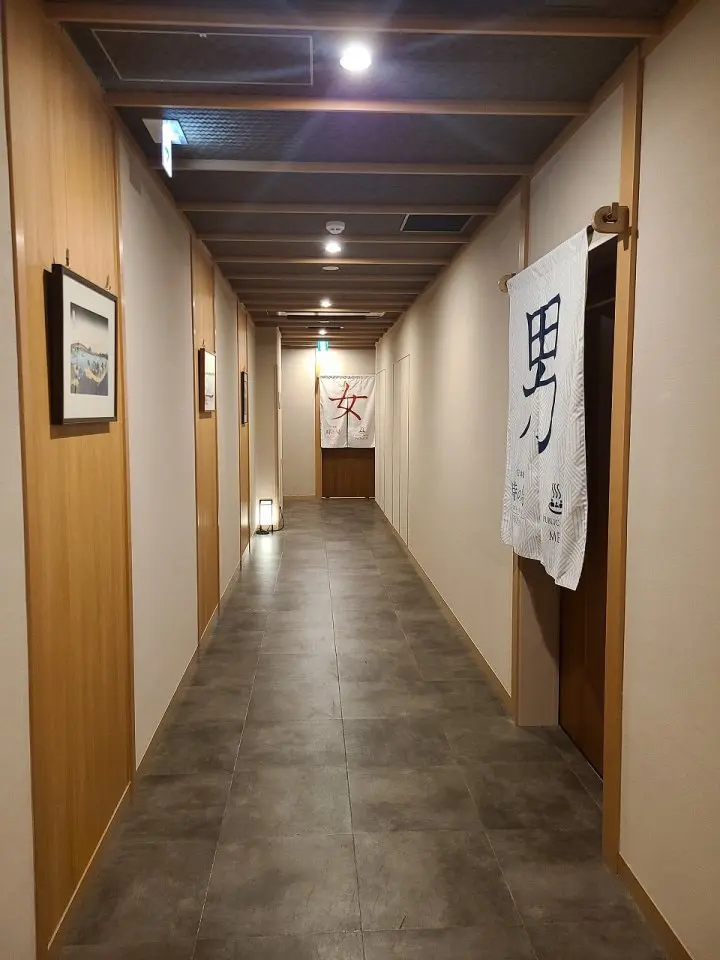
The automatic door featuring traditional Japanese woodwork leads to the public bath hallway
As I step through the automatic door into the bathhouse hallway, I am pleased to find that this hallway is heated to a very cozy temperature. Traditional noren curtains hang in front of the men’s and women’s separate entrances. Like with the elevator, security is tight. Your room key is required for access to the women’s bath area.
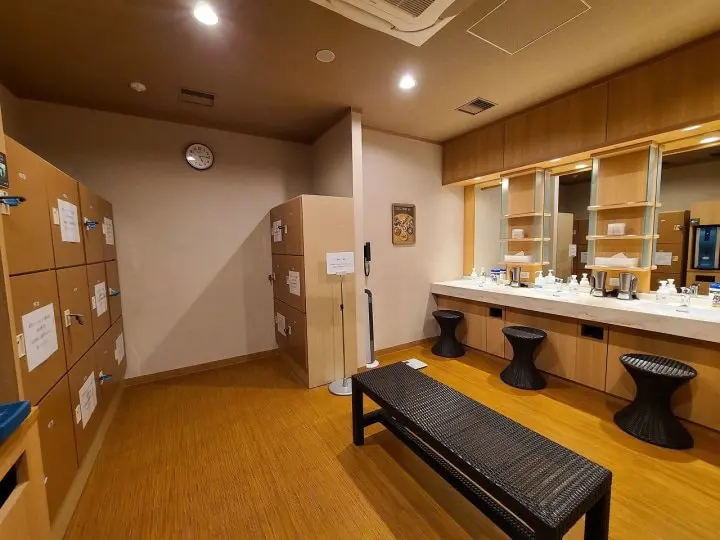
The changing/locker area
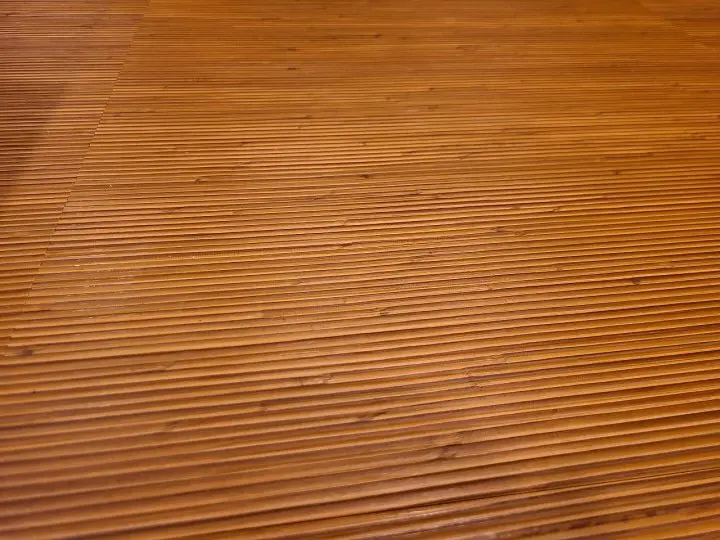
Extra care has been put into the choice of flooring, ridged wood, which has a pleasant feel under bare feet
The warm brown tones of the ridged wooden floor contrasts nicely with the woven black benches and chairs. The lighting in the bath area is subdued, and the traditional woodwork of the shoji-style wall is pleasing to the eye. After washing myself thoroughly with soap and water in the wash area outside the bath, I go in for a soak.
I have the whole place to myself, and think back on all the things I learned today. Although I have been to this area dozens of times, I had no idea that it was the stage for so many historical interactions. While the buildings have changed, the streets remain as they were hundreds of years ago.
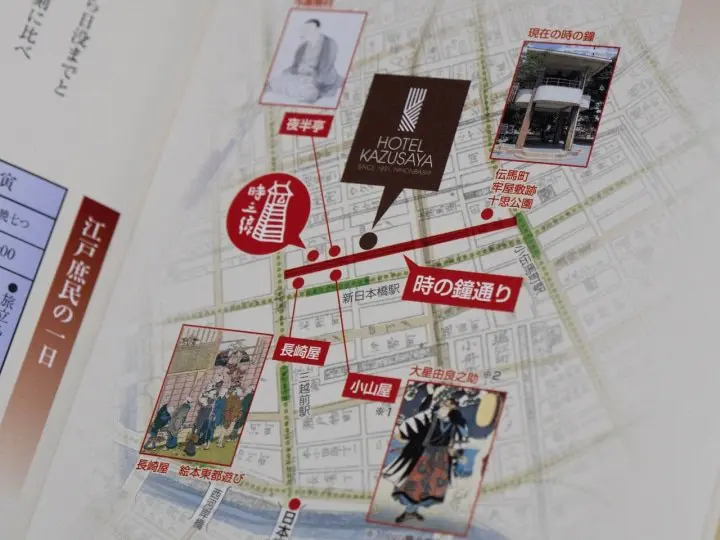
An Edo-period map showing the location of the hotel in relation to spots that famous historical figures frequented
I remember Kudo-san explaining how in the Edo period the time of day was announced by the ringing of a bell, and that only a short distance down the street was the very first bell clock tower in Japan.
I remember him mentioning how Yosa Buson, one of the three most famous haiku poets in Japanese history, for seven years lived just across the street from the hotel when he came to apprentice under his master. How famous German physician Philipp Franz von Siebold would stay at Nagasakiya just a block away and scholars from all over Japan would come to speak with him.
I imagine myself having walked down the same street that Oboshi Yuranosuke, leader of the 47 Ronin, walked on the way back to his room at Oyamaya, a small ryokan that used to exist just around the corner. The warm bath water doesn’t prevent the shiver that I feel run through my body. Perhaps it’s just my thoughts. Then again, maybe it’s something lingering in the air, left behind by spirits long gone.
I am an actress and model living in Japan. Tokyo Ryokan Stories is my essay series about less-known but amazing ryokan and hotels in Tokyo.
































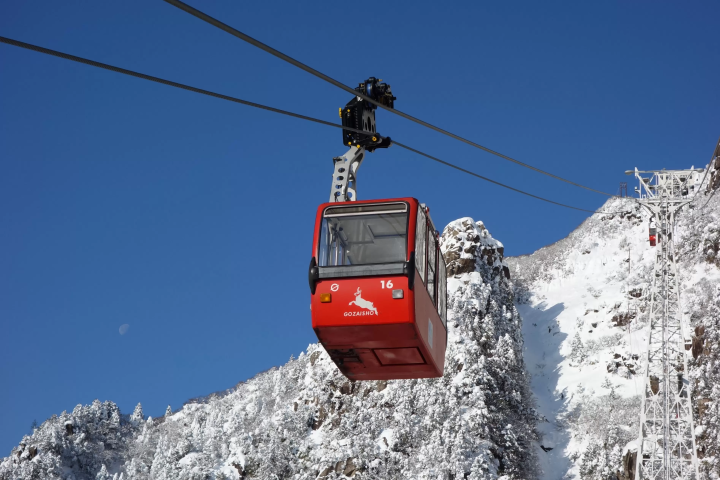
![[2026] The Matsusaka Lantern Festival will be held to light up the winter night sky!](https://resources.matcha-jp.com/resize/720x2000/2026/01/05-254777.webp)
![[List of Traditional Industry Experiences] Factory tours and craftsmanship experiences in southern Osaka and Wakayama](https://resources.matcha-jp.com/resize/720x2000/2025/11/06-249221.webp)
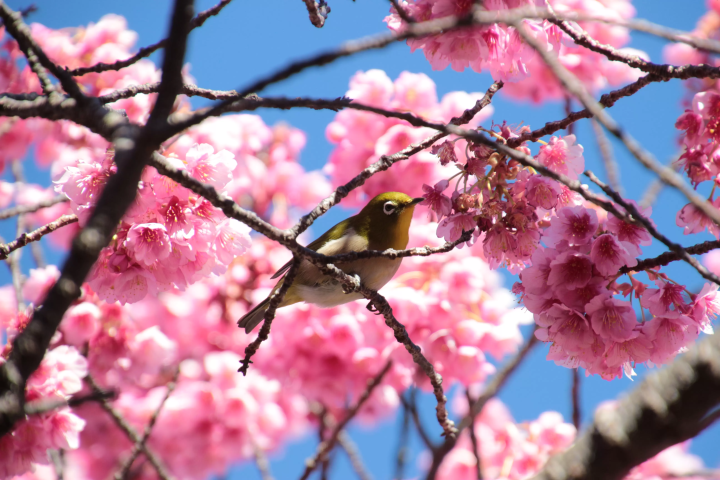
![[Coupons available] If you want to enjoy shopping for sporting goods, head to the Alpen flagship store!](https://resources.matcha-jp.com/resize/720x2000/2026/01/16-255845.webp)